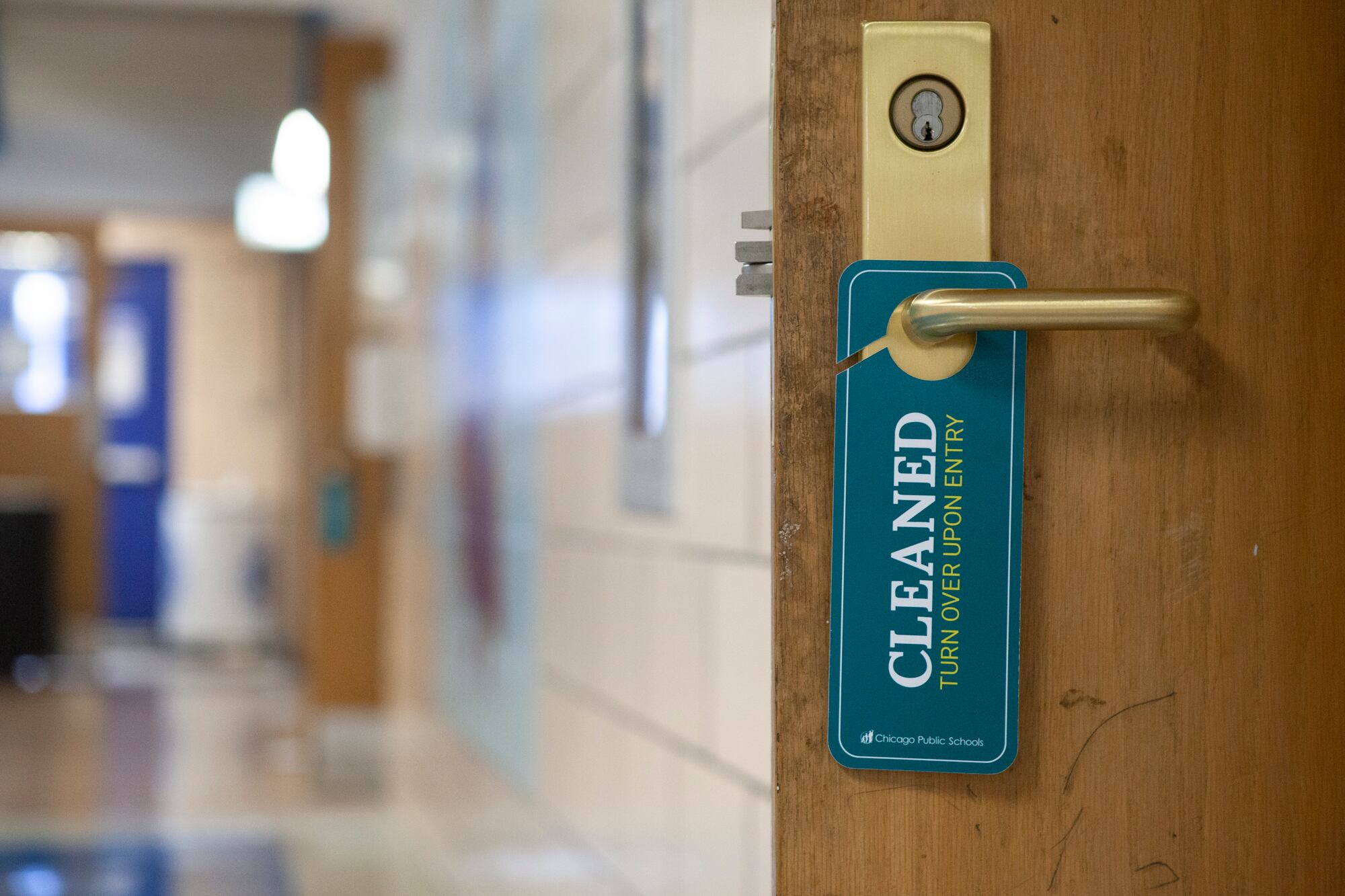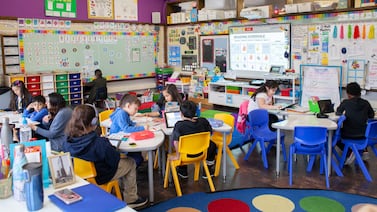When Chicago reopens its school buildings for students from kindergarten to fifth grade Monday, schools will be using gallons of hand sanitizer and liberally posted informational signs about social distancing to help implement safety protocols.
But one key aspect of Chicago Public School’s safety plan won’t be on display.
That’s the district’s COVID-19 notification and contact tracing system. The district has budgeted more than $1 million for the initiative so far, which includes a new district-level team and several online reporting programs.
In other cities where schools have reopened, notification systems have become closely scrutinized. New York City created a “Situation Room” to quickly alert school communities of COVID-19 cases, but the effort has been dogged by failures to let “close contacts” know that they may have been exposed and conflicting guidance to principals and families.
Several experts interviewed by Chalkbeat have pointed out places where Chicago’s plan is ahead of the curve - and some areas it may be lacking.
In Chicago, schools were only open for a few weeks in January before the district paused in-person learning over a labor dispute with teachers.
Now, as the district plans to bring back students from kindergarten to eighth grade, here’s what we know about Chicago’s effort so far:
Chicago has created a specialty team to oversee its notification and contact tracing system
At the center of that work is a new district-level contact tracing team that includes 10 positions, seven of which have been staffed, including a manager, as of Feb. 22. The district has budgeted $988,000 to cover those costs, for an unspecified time period. Those staff are trained through online courses offered by Johns Hopkins School of Public Health, and by members of the district’s Office of Student Health and Wellness.
Their primary focus is on figuring out when a person who tests positive for COVID-19 became contagious, and identifying whom they may have been in contact with during that period. The system is supposed to kick into gear within 24 hours of a student or educator reporting a positive COVID-19 test result on the district’s self-reporting form.
The district has also contracted with CDW Government LLC, a technology company, to create its online health screener and contact tracing case management system. In total, the district has spent $714,000 on its health screening and self-reporting portals.
Pods, an online health screener, and testing will help Chicago track any COVID-19 cases
Chicago will organize groups of in-person learners in classroom “pods” with about 15 students. Smaller numbers minimize how many people students interact with and help the school district more easily track contact.
The district will also ask staff, students and visitors who enter school buildings to fill out an online health screener to help keep track of some of the basic information it needs in case a person with COVID-19 enters a school building, and as a warning signal for anyone who reports a symptom associated with COVID-19. The screener asks whether a person has recently traveled internationally, or has any of a range of symptoms, including fatigue or a cough.
According to the district’s reopening agreement with the union, all students and employees with coronavirus symptoms will be offered a test, along with all employees as well as some students weekly in 134 schools in areas of the city with high COVID-19 rates — and half of staff in other schools. And it will offer tests to employees and students ages 10 and older newly returning to school buildings.
The reality on the ground will likely be more complicated. At many schools, educators who teach physical education, art, or music may travel between multiple pods, increasing exposure and complicating contract tracing efforts. The health screener depends on truth telling — and is likely to flag only symptomatic cases.
The district is tracking numbers and posting them publicly every week, but it’s not instantaneous
The first few weeks of school reopening in January can give some indication of what COVID-19 notification would be like. In January, Chicago Public School’s online case tracking system, which the data portal says only reports cases if a person was in a school building during the contagious period, showed 203 COVID-19 cases among staff and 15 cases among students. Nearly 4,000 staff members and 3,250 Chicago students returned to in-person classes in the first round of school reopening.
In some of those first cases, contact tracing tools helped determine where and when infected staff may have been in a building. At McCutcheon Elementary in Uptown, district officials were able to determine that a second COVID-19 case at the school was a close contact of the first, Block Club Chicago reported. Eight employees eventually had to go into quarantine in the first few days of school reopening.
The school reopening agreement with the Chicago Teachers Union spells out some protocols. If a person tests positive who was in the classroom during the contagious period, the in-person classroom would revert to remote learning. Entire campuses would pause in-person learning if there are three or more confirmed cases in a building within a 14-day period.
The agreement also mandates that each building have school-level safety committees to oversee safety complaints and weigh in on decisions about when a building may need to revert to remote learning. Those bodies are likely to play an important role.
The onus of reporting, and staying home, rests on individuals
If that health screener shows that a person has COVID-19 symptoms, or if a student or staff members tests positive, they’re asked to self-report their status to the district through an online form. That’s the backbone of the district’s contact tracing program.
From there, the district’s contact tracing team will email people identified as close contacts, which means they have been with a COVID-19-positive person in an enclosed space for 15 minutes or more, according to guidance from the Centers for Disease Control and Prevention. They will also be added to a “no admittance list” at the school level.
Positive individuals and their anyone identified as a close contact should also expect a call from the Chicago Department of Public Health. Principals are also able to communicate with schools and families about positive cases, and in some instances, even report positive cases on behalf of families.
Experts say the district’s self-reporting mechanism helps it move more nimbly than waiting on the city health department, but questioned a notification system that relies primarily on email.
Chicago Public Schools would have access to the most detailed information about where students and staff are expected to be, and who they would have contact with, which is helpful in contact tracing, said Melissa Marx, a professor at Johns Hopkins Bloomberg School of Public Health who studies child health and infectious disease. “The best practice for the school is to keep track of who is together in enclosed spaces, and do the initial notification,” she said.
But relying on email notifications to inform families of possible exposure isn’t best practice, she said. “You need to add a text option,” Marx said. “Especially for low-income folks who don’t work with computers on a regular basis or don’t have access to smartphones.”
There are still many unknowns
It’s unclear what will happen when the number of students in school buildings goes up.
Around 62,000 kindergarten to eighth grade students that opted for in-person learning are supposed to return to classrooms for the first time in nearly a year beginning Monday. That will bring significantly more students and staff into school buildings than the 3,250 Chicago students who returned to in-person classes in the first week of January.
Howard Ehrman, a professor at the University of Illinois Chicago, a former assistant commissioner of health and a vocal critic of the district’s school reopening plan, said that, with thousands of students returning to every building, the district should grow its contact tracing office. “There has to be a specific contact tracer assigned to every school,” said Ehrman.
Another potential complication may be a new strain of the virus, which recently emerged in the U.S. and appears to be especially contagious. England, where the variant originated and is rapidly spreading, announced plans in January to shutter all of its schools.
Meanwhile, the district said it has offered more than 7,500 educators vaccinations and that it plans to soon open four sites to expedite vaccinations.
And in recently released guidance, the CDC said schools can open for some in-person instruction, with regular testing and mask usage, even when community spread is high.






